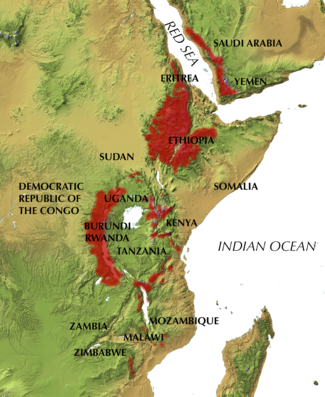Afromontane
This article needs additional citations for verification. (June 2012) |

The Afromontane regions are subregions of the Afrotropical realm, one of the Earth's eight biogeographic realms, covering the plant and animal species found in the mountains of Africa and the southern Arabian Peninsula. The Afromontane regions of Africa are discontinuous, separated from each other by lower-lying areas, and are sometimes referred to as the Afromontane archipelago, as their distribution is analogous to a series of sky islands.
Geography
Afromontane communities occur above 1,500–2,000 metres (4,900–6,600 ft) elevation near the equator, and as low as 300 metres (980 ft) elevation in the
The Afromontane archipelago mostly follows the
.Flora
Although some Afromontane enclaves are widely separated, they share a similar mix of plant species which are often distinct from the surrounding lowland regions.
The plant families
Plant communities
Afromontane areas have a wide range of plant communities, including intermediate types. These include:
- Afromontane rain forest. Afromontane rain forest is found on wetter slopes from southern Ethiopia to Malawi, mostly between 1200 and 2500 meters elevation. It occurs on wetter slopes where average annual rainfall is from 1250 to 2500 mm, or higher. Elevation and location varies somewhat based on distance from the equator or from the sea, and the size and configuration of the highland where it occurs. Mature rain forests generally have an upper stratum of trees 25 to 45 meters high, a middle stratum 14 to 30 meters high, a lower stratum 6 to 15 meters high, a shrub layer of 3 to 6 meters high, and a sparse herbaceous ground layer. The tree crowns of the upper strata are typically open, and the middle strata may be continuous but rarely forms a dense canopy, while the lower tree stratum is typically dense. Most trees are evergreen. Afromontane rain forests can be similar in structure to lowland
Distribution

In
Afromontane ecoregions
- Albertine Rift montane forests (Democratic Republic of the Congo, Burundi, Rwanda, Tanzania, Uganda)
- Cameroonian Highlands forests (Cameroon, Nigeria)
- East African montane forests (Kenya, South Sudan, Tanzania, Uganda)
- Eastern Arc forests (Tanzania, Kenya)
- Ethiopian montane forests (Djibouti, Eritrea, Ethiopia, Somalia, Sudan)
- Guinean montane forests (Guinea, Côte d'Ivoire, Liberia, Sierra Leone)
- Knysna-Amatole montane forests(South Africa)
- Southern Afrotemperate Forest (Western Cape Province of South Africa)
- Mount Cameroon and Bioko montane forests (Cameroon, Equatorial Guinea)
- Angolan montane forest-grassland mosaic(Angola)
- Angolan scarp savanna and woodlands(Angola)
- Drakensberg alti-montane grasslands and woodlands(Lesotho, South Africa)
- Drakensberg montane grasslands, woodlands and forests(Lesotho, South Africa, Eswatini)
- East African montane moorlands (Kenya, South Sudan, Tanzania, Uganda)
- Eastern Zimbabwe montane forest-grassland mosaic(Mozambique, Zimbabwe)
- Ethiopian montane grasslands and woodlands (Eritrea, Ethiopia)
- Ethiopian montane moorlands (Ethiopia)
- Highveld grasslands(Lesotho, South Africa)
- Jos Plateau forest-grassland mosaic(Nigeria)
- Maputaland-Pondoland bushland and thickets(Mozambique, South Africa, Eswatini)
- Southern Afrotemperate Forest (Western Cape Province of South Africa)
- Rwenzori-Virunga montane moorlands(Democratic Republic of the Congo, Rwanda, Uganda)
- South Malawi montane forest-grassland mosaic(Malawi, Mozambique)
- Southern Rift montane forest-grassland mosaic(Malawi, Tanzania)
- Southwestern Arabian montane woodlands (Saudi Arabia, Yemen)
External links
- Eastern Afromontane Biodiversity Hotspot (Conservation International)
- Eastern Afromontane, from Hotspots Revisited (Conservation International)
References
- Galley, C. & Linder, H. P. (2006) Geographical affinities of the Cape flora, South Africa. Journal of Biogeography 33 (2), 236–250.
